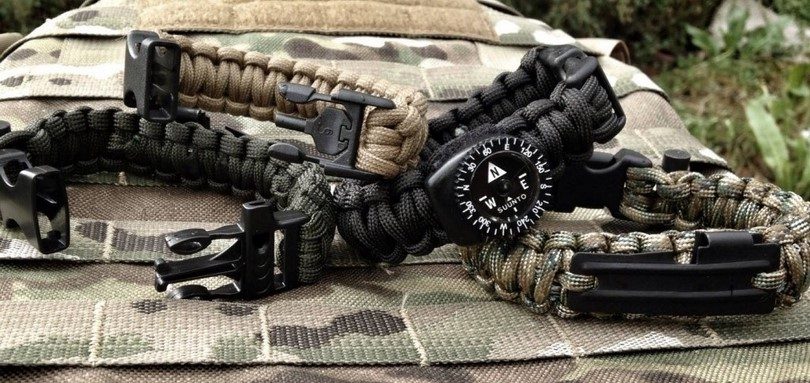Throughout the years, adventurists have relied on simple, light-weight tools that help them survive and be safe in whatever environment they may be in. From fire-proof tents and quick dry fabric to knives that don’t need sharpening and footwear that grips the terrain; each survival tool evolves into something even better as production technology becomes more seamless, more efficient and more high-tech.
[the_ad_placement id=”in-text-1-type-r”]The parachute cord bracelet, or “paracord bracelets” to enthusiasts, is relatively new to an adventurer’s arsenal of tools but the science behind it has remained unchanged as years go by. As defined by the name, a paracord bracelet is made out of the same material used for parachute suspension lines and, although primarily used by the military, it has become a staple in civilian utility equipment due to its versatility, strength and flexibility.
Parachute cords: A brief history
Parachute cords are made of a lightweight nylon rope called kernmantel which was introduced in 1953 by a German company called Edelrid, who aimed to revolutionize the rope industry by minimizing injuries caused by falling accidents during caving or climbing exercises.
The advent of this new roping technology pushed then-favored roping materials, like hemp ropes, into the brink of non-existence in activities that will require a kernmantel’s strength and flexibility.
The past sixty years had done little to affect the design and construction of kernmantel ropes despite innovations that typically aimed at cutting down the time spent in producing the ropes.
Variations are done to the characteristics of the rope to be able to meet the true purpose of the said variation. For example, the mantle, or outer layer, is woven tightly for ropes that will be used for caving. These modifications come with compromises though; ropes used for caving are difficult to knot as the mantle will be too stiff because of how they were woven.
Parachute cord composition
The term kernmantel is actually a German word meaning “core” and “sheath”; the sheath refers to the outer layer, or mantle, and the core refers to the braided strands inside the jacket. The mantle is made of 32 strands of nylon while the core is composed of two-ply nylon yarns that vary from 7 strands onwards, depending on the intended use.

In the creation of a kernmantel rope, great care is considered as to the diameter, the weight to be supported and the projected force that will impact the rope during use. Kernmantel ropes can be used either as a dynamic or a static rope. Dynamic ropes are used for belaying and can stretch to provide additional support in case of a sudden fall. Static ropes offer little stretch and is mostly used for hauling materials and tying things together.
Bracelet transformation
Ready-made parachute cord bracelets are available in the market with varying designs and prices. Some are made of two or more pieces of parachute cords while some have a small knife tucked away in between the braids of the bracelet.

While this is the easier option, one can always make their own bracelet and create a design of their own.
Materials needed
- Parachute cord, preferably more than 12 feet
- Buckles, the one found in bags
- Scissors
- Lighter
- Candle
- Marker
- Ruler or tape measure (the ones tailors use)
Instructions
- Preparing the rope.
- Make sure that the ends of the rope do not fray and is cut evenly.
- If the core is exposed, cut the exposed portion for a nicer burn.
- Light up the candle and apply the flame to the rope by rotating the cord evenly, pausing for about 2-3 seconds per turn.
- Once the ends have melted, close it down using pliers.
- Creating the male half of the buckle.
- Take the male half of the buckle and the two ends of the cord and insert both of them in the bottommost slot.
- Pull both ends until the “u-turn” arc is close.
- Slide both ends into the arc and pull until a knot if formed, securing the male half in place.
- Sizing up
- Measure the wrist by wrapping the tape measure around it.
- Wrap the tape tightly to get a more accurate measure.
- Lay the tape measure side by side with the rope, the male half of the buckle should be at the zero point of the tape measure.
- Flatten both the tape and the rope and check where measurement is on the rope.
- Add about one-inch for good measure.
- Setting up the female.
- Insert the loose ends into the female half of the buckle and pull until it reaches the predetermined measurement of the wrist.
- Secure the female in place by creating a knot using the loose ends.
- Take the left end and weave it under the cords.
- Take the right piece and weave it above the middle cords and inserting it on the loop created by the left.
- Pull tightly until a knot is formed.
- Braiding
- To braid the whole bracelet, repeat Steps 4.b.i to 4.b.iii until one reaches the male half of the buckle.
- Pull on the male half from time to time to squeeze the braids towards the female half, allowing for more room for braiding.
- Finishing up
- Once slack has been achieved and the end of the bracelet reached, one can now close it using the last braid and the loose ends.
- Take both loose ends and insert them in the available slot on the male half and bring them back.
- Slightly unravel the last braid and insert the loose ends and pull tightly.
- Cut the rope a quarter-of-an-inch from the last braid.
- Close the cut using the candle technique used in Step 1.
We also have other great DIY tutorials on how to make a paracord bracelet that you can check out here.
Purchasing a parachute cord bracelet
If in case one does not have the necessary skill set for a DIY project, here are some pointers to watch out for when investing in parachute cord bracelets.
- Usage – What will be the use the unraveled bracelet? Will heavy impact usage on the cords be expected?
- Length – Parachute cord bracelet design are dependent on the weaves that were used, some simple weaves or patterns provide for about one foot of parachute cord for every inch of the bracelet while some complicated weaves, like the King Cobra weave, offer twice that for every inch of bracelet.
Like most products in the market, there are some parachute cord bracelet knock-offs out there. These are dangerous to purchase as they could not guarantee one’s safety.
[the_ad_placement id=”in-text-2-type-r”]To determine if the parachute cord bracelet is fake or not, one can do the following tests to ascertain authenticity.
- Core check – some fake bracelets don’t have any inner cords at all and are just filled with cotton like materials, ask to check the core of the parachute cord first.
- Strand check – check the strands for the materials that were used, fake bracelets commonly use cotton and have only four strands in the core. They also wrinkle once taken out of the sheath while the real ones are still straight even after being removed from the sheath.
- Sheath check – the sheaths on fake bracelets retract and fray easily once cut, while real ones stay intact unless force is placed.
- Stiffness – a true parachute cord bracelet, once unclasped, will not unfold easily, it remains stiff for a while.
- Fire – Disclaimer: ask permission first before doing this test. Authentic parachute cord bracelets will melt while the fake ones will light up like a candle wick.
For more information on how to choose the best product, you should read our reviews containing info on the best paracord bracelets on the market.
Surviving with paracord bracelets
Specifically for outdoorsmen and survivalists, parachute cord bracelets have a lot of verified uses and there are still some potential that has not been explored yet.

Below is a list of known uses for paracord bracelets and how to effectively use them in their particular scenarios.
Food
One of the basic essential needs of any human being, surviving outdoors is close to impossible if one is not able to nourish oneself.
Hunt
Create a bow:
- Find a good sized stick that will not break easily.
- Unravel one of the core cords and tie it on one end of the stick.
- Slowly and gently pull the string to the end so that the stick will bend like a bow.
- Tie the other end tightly and check the line for tautness.
- Aim and shoot.
See: Paracord Rifle Sling: A DIY Project with Instructions
Fish
Find a good fishing spot.
- Take out one of the core cords.
- Fashion a hook from a safety pin.
- Cast the line.
If a hook is not available, take out all core cords and create a gill net.
- Lay out all cords.
- Arrange one set going up and down while the other going from left to right.
- Tie a simple knot at the intersections.
- Throw and wait for a catch.
Trap
Set-up snares using the core cords.
- Scout a location where animal trails run through.
- Find a discrete location.
- Place two stakes into the ground.
- Create a simple slip knot.
- Hang the loop on the stake notches and wait.
Shelter
Another basic essential, shelter protects us from the elements, ensuring that one is able to survive and go home.
Improvised shelter:
- Gather some sturdy branches or logs to serve as the frame.
- If a tarp is not handy, gather leafy branches as well.
- Unweave the bracelet and secure the frame using the cords.
- Secure the tarp or leafy branches with the remaining cords. This type of shelter is called a lean-to.
Repair a tent:
- Unravel the inner cords and use them as thread in sewing up any torn portions of the tent.
- If a needle is not available, use the cords to make a rudimentary not to seal the gap.
Secure the tent:
- Sometimes, the weather would just not cooperate no matter how good the start of the trip is. In case of strong head winds, use the paracord bracelet as an additional guy line to provide additional support.
Hammocks:
- Parachute cord bracelets can also be used to secure a hammock to a tree. One should not unweave them to preserve the tensile integrity.
See: Paracord Survival Belt: Why You Should Wear One
First aid
Accidents happen at any time and in addition to the standard first aid kit, parachute cord bracelets can also be used for the following:
Splint:
- Depending on the extent of the injury, one may opt not to unravel the inner cords and just secure the splints with the unwoven bracelet.
Tourniquet:
- Dynamic ropes are not effective as tourniquets as they will stretch and, ergo, defeat the purpose of a tourniquet. Static ropes on the other hand can somewhat help stop the bleeding as long as it is pulled tightly and checked every once in a while for slack.
Emergency sutures:
- The inner cords can also be used as emergency suture for gaping wounds, especially if medical help is far away. Please take note though that this is just for really desperate situations. Parachute cord bracelets are not hygienic, unless treated using steam and antibacterial solution.
Survival
Bags
- Sew up tears using the inner cords.
- Use the paracord as an emergency shoulder strap.
Shoes
- Unweave the core cords and use them as replacement for broken shoe laces.
- Use the inner cords to provide additional strength in rough terrain.
- Sew broken shoes together using the inner cords.
Clothes
- Unweave the inner cords and use them as thread to repair clothes.
Floss with it:
- In case of emergency, one can use the strands from the inner cords as an improvised dental floss. Make sure to clean it afterwards.
Hang with it:
- Parachute cords can support heavy loads and thus can be used to hang bags or tools from a tree or a belt loop. One can also this to hang food from the ground to deter wild animals from getting to it.
Belay with it:
- The bracelets can be unwoven, tied together with secure knots and then serve as rescue or belaying ropes.
Dry with it:
- Unwoven bracelets can also be used as a clothesline to dry wet things on as well as cure meat and/or fish.
Secure things with it:
- Given the material used, one can also use the parachute cord bracelets to secure garbage bags to backpacks or backpacks to vehicles or trees.
- Paracord bracelets can also be used to secure boats to a tree or a skiff.
Discover fire:
- This requires a far more advanced skill set but anyone who went through cub scouts can possibly do this trick.
- Using the bow method, one can start a fire by collecting:
- a branch that would not easily break when bent to serve as the bow
- a stone to serve as the socket
- another piece of wood as the spindle
- a flat piece of wood as the fire board
- some tinder
- Create a small bow using the bendable branch and loop the string into the spindle.
- Place some tinder into the notch created on the fire board.
- Hold the spindle in place while one performs a saw-like motion with the bow.
- Move it faster to create fiction, which will in turn generate heat and ignite the tinder in the notch.
- Using the bow method, one can start a fire by collecting:
Never get lost:
- Probably one of the most important reminders to all outdoors men is to watch the trail to avoid being lost.
- As taught in basic mountaineering, one can make trail marks as they go along. This would also help others determine the correct path.
- Unravel the bracelet and cut the rope into pieces, about 6 inches in length.
- Tie the pieces on trees, especially on areas of concern like forks and water sources.
- One may opt to untie the pieces as they go back or leave them for other enthusiasts as a sign of courtesy.
You should also take a look at our article on how to use paracord in emergency situations, in case you will ever need it.
Bracelet maintenance
Parachute cord bracelets made of kernmantel should be checked before and after any outdoor activity for any damage like frayed ends, stressed sections and abraded sheaths.
[the_ad_placement id=”in-text-3-type-r”]Frayed ends should be cut cleanly and flamed should be applied to close them up. Stressed sections are often the thinner sections of the rope, one can opt to cut it there and tie the remaining pieces together. Abraded sheaths appear in cords that have been extensively used in caving and rappelling; they appear as cuts along the mantle and vary in size. Severely damaged cords should not be used outdoors anymore as their integrity is compromised and may not meet the demands of the user.

Kernmantel is washable and it is possible for a user to place their parachute cord bracelets in the belt loop of their pants and then throw them in the wash. Another advisable method is to use soap, water and an old toothbrush to give the parachute cord bracelet the tender loving care that it deserves.
Parachute cord bracelets is an indispensable survival tool that is currently gaining popularity thanks to reality TV shows and their hosts, like Bear Grylls, who has patronized the use of the bracelets during his stints.
For more DIY projects using your paracord, see our article on how to make different paracord bracelet patterns for a variety of uses.






A basic approach to adding some paracord to your gear besides the standard bracelet is to wrap the handle of your bag utilizing one of the norm weaves. It doesn’t just add solace to the nylon handle on my portable PC bag pack. Also, it gives me around 25 ft of promptly accessible cordage in case I require it.
Bought something like this on amazon but my dilemma is that it is not adjustable so i gues i need to buy another one that fits me. but more than that, it is very functional piece especially when you’re hiking or camping.
I bought some paracord a few weeks back and I tried lighting them up. They were authentic enough that they melted; however, they didn’t close up into a hardened end but rather a fragile-looking strand. Maybe I did something wrong with melting it?
Working with Paracord is easy, especially when making bracelets. All you need is practice.